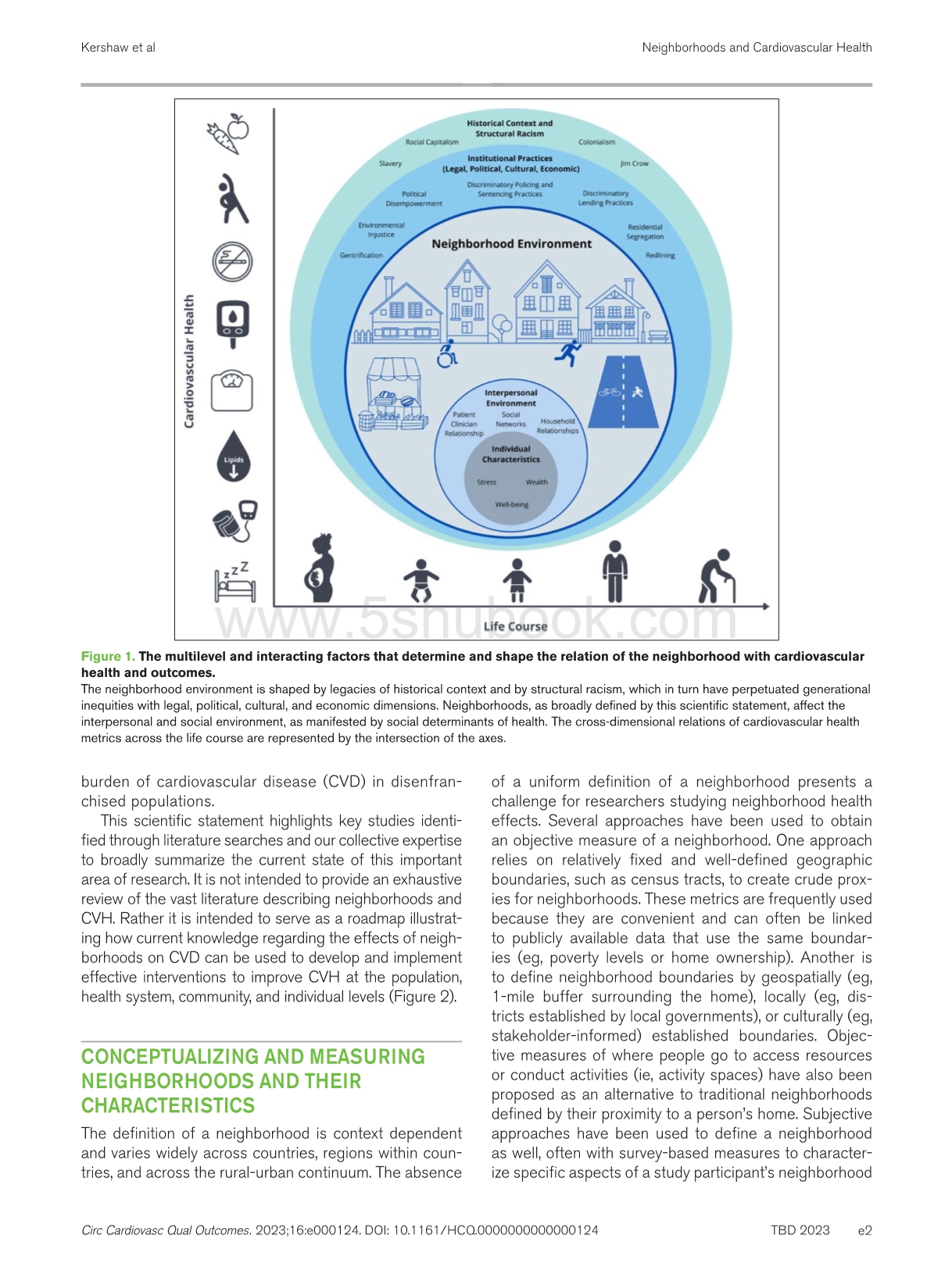
 2023+AHA科学声明:社区和心血管健康(英文版).pdf
2023+AHA科学声明:社区和心血管健康(英文版).pdf
《2023+AHA科学声明:社区和心血管健康(英文版).pdf》由会员分享,可在线阅读,更多相关《2023+AHA科学声明:社区和心血管健康(英文版).pdf(14页珍藏版)》请在周易易学书店|道易五术书社上搜索。
1、e1 Circ Cardiovasc Qual Outcomes.2023;16:e000124.DOI:10.1161/HCQ.0000000000000124 TBD 2023Circulation:Cardiovascular Quality and Outcomes is available at http:/www.ahajournals.org/journal/circoutcomesCirculation:Cardiovascular Quality and OutcomesAHA SCIENTIFIC STATEMENTNeighborhoods and Cardiovascu
2、lar Health:A Scientific Statement From the American Heart AssociationKiarri N.Kershaw,PhD,MPH,FAHA,Chair;Jared W.Magnani,MD,MSc,FAHA,Vice Chair;Ana V.Diez Roux,MD,PhD,MPH;Marlene Camacho-Rivera,ScD,MPH;Elizabeth A.Jackson,MD,FAHA;Amber E.Johnson,MD,MS,MBA;Gayenell S.Magwood,PhD,RN,FAHA;Lewis B.Morge
3、nstern,MD,FAHA;Jennifer J.Salinas,PhD;Mario Sims,PhD,FAHA;Mahasin S.Mujahid,PhD,MS,FAHA;on behalf of the Council on Quality of Care and Outcomes Research;Council on Epidemi-ology and Prevention;Council on Clinical Cardiology;Council on Hypertension;Council on Cardiovascular and Stroke Nursing;Counci
4、l on Peripheral Vascular Disease;and Council on the Kidney in Cardiovascular DiseaseABSTRACT:The neighborhoods where individuals reside shape environmental exposures,access to resources,and opportunities.The inequitable distribution of resources and opportunities across neighborhoods perpetuates and
5、 exacerbates cardiovascular health inequities.Thus,interventions that address the neighborhood environment could reduce the inequitable burden of cardiovascular disease in disenfranchised populations.The objective of this scientific statement is to provide a roadmap illustrating how current knowledg
6、e regarding the effects of neighborhoods on cardiovascular disease can be used to develop and implement effective interventions to improve cardiovascular health at the population,health system,community,and individual levels.PubMed/Medline,CINAHL,Cochrane Library reviews,and ClinicalTrials.gov were
7、used to identify observational studies and interventions examining or targeting neighborhood conditions in relation to cardiovascular health.The scientific statement summarizes how neighborhoods have been incorporated into the actions of health care systems,interventions in community settings,and po
8、licies and interventions that involve modifying the neighborhood environment.This scientific statement presents promising findings that can be expanded and implemented more broadly and identifies methodological challenges in designing studies to evaluate important neighborhood-related policies and i
9、nterventions.Last,this scientific statement offers recommendations for areas that merit further research to promote a deeper understanding of the contributions of neighborhoods to cardiovascular health and health inequities and to stimulate the development of more effective interventions.Key Words:A
10、HA Scientific Statements cardiovascular diseases health inequities neighborhood characteristics residential segregation The neighborhoods where individuals reside shape environmental exposures,access to resources,and opportunities.In empirical studies,neighborhoods are often evaluated using static m
11、easures assessed at a given point in time,but it is important to recognize that neighborhoods are dynamic.The composition of neigh-borhoods and the resources they provide or deny certain groups are shaped and reconfigured due to a constel-lation of historical and contemporary structural,cultural,and
12、 societal factors,including population decline,urban renewal and gentrification,immigration,and discrimina-tory or predatory lending practices.Neighborhood features relevant to cardiovascular health(CVH)include access to high-quality education,stable housing,public transportation,and jobs;prox-imity
13、 to environmental and industrial exposures,health care facilities,healthy foods,and spaces for congre-gation,exercise,and recreation;and environmen-tal stressors such as safety(Figure 1).1 Exposure to these factors may affect CVH through multiple path-ways,such as the development of poor CVH behavio
14、rs and health factors(eg,Lifes Essential 8),or through direct physiological processes tied to chronic stress and accelerated aging.1,2 The inequitable distribu-tion of essential resources for optimal health across neighborhoods exacerbates CVH inequities.Thus,interventions that affect and improve ne
15、ighborhood environments can potentially reduce the inequitable Supplemental Material is available at https:/www.ahajournals.org/doi/suppl/10.1161/HCQ.0000000000000124 2023 American Heart Association,Inc.Kershaw et al Neighborhoods and Cardiovascular HealthCirc Cardiovasc Qual Outcomes.2023;16:e00012
16、4.DOI:10.1161/HCQ.0000000000000124 TBD 2023 e2burden of cardiovascular disease(CVD)in disenfran-chised populations.This scientific statement highlights key studies identi-fied through literature searches and our collective expertise to broadly summarize the current state of this important area of re
17、search.It is not intended to provide an exhaustive review of the vast literature describing neighborhoods and CVH.Rather it is intended to serve as a roadmap illustrat-ing how current knowledge regarding the effects of neigh-borhoods on CVD can be used to develop and implement effective intervention
18、s to improve CVH at the population,health system,community,and individual levels(Figure 2).CONCEPTUALIZING AND MEASURING NEIGHBORHOODS AND THEIR CHARACTERISTICSThe definition of a neighborhood is context dependent and varies widely across countries,regions within coun-tries,and across the rural-urba
19、n continuum.The absence of a uniform definition of a neighborhood presents a challenge for researchers studying neighborhood health effects.Several approaches have been used to obtain an objective measure of a neighborhood.One approach relies on relatively fixed and well-defined geographic boundarie
20、s,such as census tracts,to create crude prox-ies for neighborhoods.These metrics are frequently used because they are convenient and can often be linked to publicly available data that use the same boundar-ies(eg,poverty levels or home ownership).Another is to define neighborhood boundaries by geosp
21、atially(eg,1-mile buffer surrounding the home),locally(eg,dis-tricts established by local governments),or culturally(eg,stakeholder-informed)established boundaries.Objec-tive measures of where people go to access resources or conduct activities(ie,activity spaces)have also been proposed as an altern
22、ative to traditional neighborhoods defined by their proximity to a persons home.Subjective approaches have been used to define a neighborhood as well,often with survey-based measures to character-ize specific aspects of a study participants neighborhood Figure 1.The multilevel and interacting factor
23、s that determine and shape the relation of the neighborhood with cardiovascular health and outcomes.The neighborhood environment is shaped by legacies of historical context and by structural racism,which in turn have perpetuated generational inequities with legal,political,cultural,and economic dime
24、nsions.Neighborhoods,as broadly defined by this scientific statement,affect the interpersonal and social environment,as manifested by social determinants of health.The cross-dimensional relations of cardiovascular health metrics across the life course are represented by the intersection of the axes.
25、e3Kershaw et al Neighborhoods and Cardiovascular HealthCirc Cardiovasc Qual Outcomes.2023;16:e000124.DOI:10.1161/HCQ.0000000000000124 TBD 2023(eg,walkability)either without specifying a frame of ref-erence or by providing one,such as the area within a 20-minute walk from home.Initial studies focused



- 配套讲稿:
如PPT文件的首页显示word图标,表示该PPT已包含配套word讲稿。双击word图标可打开word文档。
- 特殊限制:
部分文档作品中含有的国旗、国徽等图片,仅作为作品整体效果示例展示,禁止商用。设计者仅对作品中独创性部分享有著作权。
- 关 键 词:
- aha 科学 声明 社区 以及 心血管 健康
 周易易学书店|道易五术书社所有资源均是用户自行上传分享,仅供网友学习交流,未经上传用户书面授权,请勿作他用。
周易易学书店|道易五术书社所有资源均是用户自行上传分享,仅供网友学习交流,未经上传用户书面授权,请勿作他用。









 《风湿病中医特色治疗》·吴启富.pdf(342页)
《风湿病中医特色治疗》·吴启富.pdf(342页)
 【2016爱爱医中医擂台赛】:协定处方院内验方 院内制剂汇集(骨伤科类)天津市中医院.doc(2页)
【2016爱爱医中医擂台赛】:协定处方院内验方 院内制剂汇集(骨伤科类)天津市中医院.doc(2页)
 穴位贴敷疗法(中医特色治疗).ppt(14页)
穴位贴敷疗法(中医特色治疗).ppt(14页)
